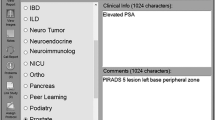Abstract
Multidisciplinary meetings (MDMs) are an essential part of the management of head and neck cancer. Practice care guidance set up by the British Association of Head and Neck Oncologists has recommended that MDMs should have appropriate projection equipment for computer-generated images so that all members of group have access to the same information. The aim of this paper is to review our experience with the integrated visual presentation of head and neck oncology patients and to demonstrate its advantages over conventional approaches. Digital photographs are taken of patients and of their index tumour at presentation or at the time of diagnostic endoscopy. All relevant pre-treatment digitised images from tumour sites and radiological images and histological slides are incorporated into a single presentation using Microsoft PowerPoint software®. During the past 2 years, on-line radiological scans have also become accessible for the meeting to aid treatment planning. Subsequently, all peri-operative pictures and post-surgical macroscopic and microscopic histopathological images are added to each patient’s presentation, which is then hyperlinked into the agenda. The Guy’s and St Thomas’ Head and Neck Cancer Centre treats over 400 patients a year, and since 2002, all new cancer diagnoses have been discussed in the weekly MDM as described above. A total of 1,638 presentations have been incorporated in a centralized database that is updated in the event of recurrence, further primary tumours or other clinical developments. Satisfactory documentation and staging of head and neck tumours must include a verbal description, accurate measurement, diagrammatic representation, photographic recording and appropriate radiological imaging. Integrated presentation at MDM collates all relevant findings for clinical management decisions on patients with head and neck cancer. This approach is also an extremely valuable adjunct to long-term clinical monitoring.

Similar content being viewed by others
References
British Association of Head and Neck Oncologists (2001) Practice care guidance for clinicians participating in the management of head and neck cancer patients in the UK. Drawn up by a Consensus Group of Practising Clinicians. Eur J Surg Oncol 27(Suppl A):S1–S17
British Association of Otorhinolaryngologists—Head and Neck Surgeons (2002) Effective head and neck cancer management. Consensus document. British Association of Otorhinolaryngologists—Head and Neck Surgeons, London
National Institute for Clinical Excellence (2004) Improving outcomes in head and neck cancer—the manual. National Institute for Clinical Excellence, London
American College of Surgeons, American Joint Committee on Cancer and American Cancer Society (1998) Head and neck cancer sites. In: AJCC cancer staging manual, serial number 19106-3708. Lippincott Williams and Wilkins, Philadelphia, pp 25–64
International Union Against Cancer (UICC) (1997) TNM atlas. Illustrated guide to the TNM/pTNM classification of malignant tumors. Springer, Berlin, pp 5–70
von Haacke N, Croft CB (1984) Documenting tumours of the head and neck. J Laryngol Otol 98:1009–1011
Shedd DP (1969) A system for the documentation of cancer of the upper aerodigestive tract. J Surg Oncol 1(3):229–239
Simo R, Yong L, Kothari P, Pracy P (2002) Diagrammatic recording of head and neck tumours. Clin Otolaryngol 27(5):374–377
Robbins KT, Medina JE, Wolfe GT, Levine PA, Sessions RB, Pruet CW (1991) Standardizing neck dissection terminology—official report of the Academy’s Committee for Head and Neck Surgery and Oncology. Arch Otolaryngol Head Neck Surg 117:601–605
Robbins KT, Denys D (2001) The American Head and Neck Society’s revised classification for neck dissection. In: Proceedings of the 5th international conference on head and neck cancer. American Head and Neck Society, Pittsburgh, pp 365–371
Caglar HB, Allen AM (2007) Intensity-modulated radiotherapy for head and neck cancer. Clin Adv Hematol Oncol 5(6):425–431. (Review)
Conflict of interest statement
The authors declare that they have no conflict of interest.
Author information
Authors and Affiliations
Corresponding author
Additional information
See also Editorial at doi:10.1007/s00405-008-0883-6.
Rights and permissions
About this article
Cite this article
Simo, R., Morgan, P., Jeannon, JP. et al. Integrated media presentation in multidisciplinary head and neck oncology meetings. Eur Arch Otorhinolaryngol 266, 261–265 (2009). https://doi.org/10.1007/s00405-008-0819-1
Received:
Accepted:
Published:
Issue Date:
DOI: https://doi.org/10.1007/s00405-008-0819-1




